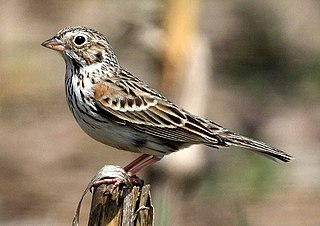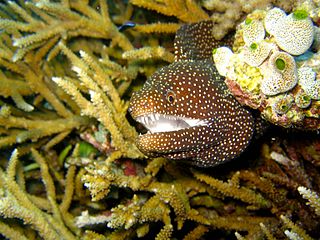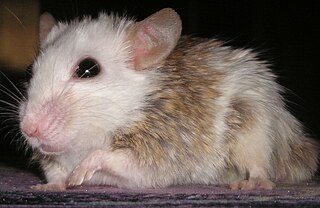
Protea cynaroides, also called the king protea, is a flowering plant. It is a distinctive member of Protea, having the largest flower head in the genus. The species is also known as giant protea, honeypot or king sugar bush. It is widely distributed in the southwestern and southern parts of South Africa in the fynbos region.

Kiwi are flightless birds endemic to New Zealand of the genus Apteryx and family Apterygidae. Approximately the size of a domestic chicken, kiwi are by far the smallest living ratites.

Weasels are mammals of the genus Mustela of the family Mustelidae. The genus Mustela includes the least weasels, polecats, stoats, ferrets and mink. Members of this genus are small, active predators, with long and slender bodies and short legs. The family Mustelidae, or mustelids, is often referred to as the "weasel family". In the UK, the term "weasel" usually refers to the smallest species, the least weasel (M. nivalis), the smallest carnivoran species.

Nightjars are medium-sized nocturnal or crepuscular birds in the family Caprimulgidae and order Caprimulgiformes, characterised by long wings, short legs, and very short bills. They are sometimes called goatsuckers, due to the ancient folk tale that they sucked the milk from goats, or bugeaters, their primary source of food being insects. Some New World species are called nighthawks. The English word "nightjar" originally referred to the European nightjar.

Aster is a genus of perennial flowering plants in the family Asteraceae. Its circumscription has been narrowed, and it now encompasses around 170 species, all but one of which are restricted to Eurasia; many species formerly in Aster are now in other genera of the tribe Astereae. Aster amellus is the type species of the genus and the family Asteraceae.

Echinacea is a genus of herbaceous flowering plants in the daisy family. It has ten species, which are commonly called coneflowers. They are found only in eastern and central North America, where they grow in moist to dry prairies and open wooded areas. They have large, showy heads of composite flowers, blooming in summer. The generic name is derived from the Greek word ἐχῖνος, meaning "sea urchin", due to the spiny central disk. These flowering plants and their parts have different uses. Some species are cultivated in gardens for their showy flowers. Two of the species, E. tennesseensis and E. laevigata, are listed in the United States as endangered species.

Bandicoots are a group of more than 20 species of small to medium-sized, terrestrial, largely nocturnal marsupial omnivores in the order Peramelemorphia. They are endemic to the Australia–New Guinea region, including the Bismarck Archipelago to the east and Seram and Halmahera to the west.

The Lamniformes are an order of sharks commonly known as mackerel sharks. It includes some of the most familiar species of sharks, such as the great white, as well as more unusual representatives, such as the goblin shark and megamouth shark.

The vesper sparrow is a medium-sized New World sparrow. It is the only member of the genus Pooecetes.

Lagenorhynchus is a genus in the infraorder Cetacea, containing only a single extant species as of 2021: the white-beaked dolphin. In addition, the extinct species Lagenorhynchus harmatuki is also classified in this genus.

Moray eels, or Muraenidae, are a family of eels whose members are found worldwide. There are approximately 200 species in 15 genera which are almost exclusively marine, but several species are regularly seen in brackish water, and a few are found in fresh water.
The abbreviation cf. is used in writing to refer the reader to other material to make a comparison with the topic being discussed. Style guides recommend that cf. be used only to suggest a comparison, and the word 'see' be used to point to a source of information.

Okavirus is a genus of enveloped positive-strand RNA viruses which infect crustaceans. Host organisms are mostly shrimp. It is the only genus in the family Roniviridae. Viruses associated with the genus include: gill-associated virus (GAV) which causes reddening, biofouling with exoparasites, emaciation, and massive mortality; and yellow head virus (YHV) which causes yellow head, arrest of feeding, and massive mortality. The name is derived from the 'Oka' or lymphoid organ in which the viruses are commonly detected and in which pathology occurs during acute infections. Lymphoid organs are anatomical structures common to penaeid shrimp. There are three species in this genus.

Pultenaea is a genus of about 100 species of flowering plants in the family Fabaceae, and is endemic to Australia. Plants in this genus are shrubs with simple leaves and orange or yellow flowers similar to others in the family but with the standard petal equal to or slightly longer than the other petals.
Rubivirus is a genus of viruses. It contains three species.

Mastomys is a genus of rodent in the family Muridae endemic to Africa. It contains these species:

Calectasia is a genus of about fifteen species of flowering plants in the family Dasypogonaceae and is endemic to south-western Australia. Plants is this genus are small, erect shrubs with branched stems covered by leaf sheaths. The flowers are star-shaped, lilac-blue to purple and arranged singly on the ends of short branchlets.

Lutjanidae, or snappers are a family of perciform fish, mainly marine, but with some members inhabiting estuaries, feeding in fresh water. The family includes about 113 species. Some are important food fish. One of the best known is the red snapper.

Mitovirus is a genus of positive-strand RNA viruses, in the family Mitoviridae. Fungi serve as natural hosts. There are five species in the genus.

Grevillea tenuiflora, also commonly known as amber grevillea, is a shrub of the genus Grevillea native to an area in the Wheatbelt and Mid West regions of Western Australia.

















